TENCEL vs polyester – what’s the difference?!
Looking to enhance your activewear wardrobe? If so, you may be considering workout clothes made from TENCEL or polyester.
Polyester is a ubiquitous material found in most mainstream activewear. That said, TENCEL is a rising sustainable star on the sportswear stage and is becoming the fabric of choice for brands and consumers alike.
But how do they compare? Do they possess any common threads? How does each one perform? Are they skin-friendly? Is one more sustainable than the other?
This TENCEL vs polyester guide is a deep dive into the pros and cons of each material. Discover which fabric is right for you while feeling empowered to make the best decision for yourself, people and nature.
Are you ready to get started? We’re bursting at the seams!
TENCEL vs Polyester: Our Verdict

Caption: Pressed for time? Here are our main takeaways when comparing TENCEL vs polyester.
TENCEL vs Polyester: Key Definitions
What is TENCEL Lyocell Fabric?
If you’re making the move to sustainable activewear, then perhaps you’ve heard of TENCEL Lyocell. If you haven’t, don’t worry, because we’re here to demystify this pioneering material for you!
TENCEL, or TENCEL Lyocell, is a renewable natural raw material derived from regenerated cellulosic fibers. It follows a resource-saving and environmentally friendly closed loop process. In other words, virtually no waste enters the environment. Instead, water and toxic-free solvent is reused at a rate of more than 99% during production. Plus, the fibers themselves are certified biodegradable and compostable. This means they can fully revert back to nature at the end of their long, natural life!
The wood pulp is sourced from Europe and comes from sustainably managed trees such as eucalyptus trees. The wood is certified according to recognised sustainability criteria, including the Forest Stewardship Council and Programme for the Endorsement of Forest Certification.
In an increasingly eco-conscious world, TENCEL is becoming the nature-powered fabric of choice. Many brands and consumers are benefiting from this life-changing fabric – including Tripulse! Find out more about our repertoire of responsible materials.

Caption: When considering TENCEL vs polyester, it's important to understand how TENCEL is made. Here is an overview of the TENCEL closed-loop production process. Wood pulp is transformed in to TENCEL and 99% of the water and toxic-free solvent is reused again.
Are TENCEL and Generic Lyocell the Same?
But wait, is there a difference between TENCEL and generic lyocell?
There certainly is! Here’s a quick breakdown of TENCEL vs lyocell:
- Firstly, TENCEL is the branded name of Austria company Lenzing AG and is what we’re referring to in this article when comparing TENCEL vs polyester. TENCEL shouldn't be confused with other wood-based fabrics such as viscose or rayon. The wood pulp used to make TENCEL branded lyocell is sourced from certified and sustainably managed forests. TENCEL consumes 50% less carbon emissions and water compared to generic lyocell.
- There is no guarantee traditional lyocell is manufactured sustainably. Traditional viscose is semi-synthetic and follows a highly polluting and chemically-intensive process. Toxins often escape into the environment which poses a great risk to wildlife and human health.
- The harvesting of wood pulp for viscose fashion is environmentally problematic. Approximately 200 million trees are felled for fashion each year. Of the 6.5 million metric tonnes of rayon produced annually, almost half comes from ancient and endangered forests.
Considering investing in lyocell clothing? Choose garments with the TENCEL™ trademark!
Discover high-performing and versatile sustainable activewear made with TENCEL™.
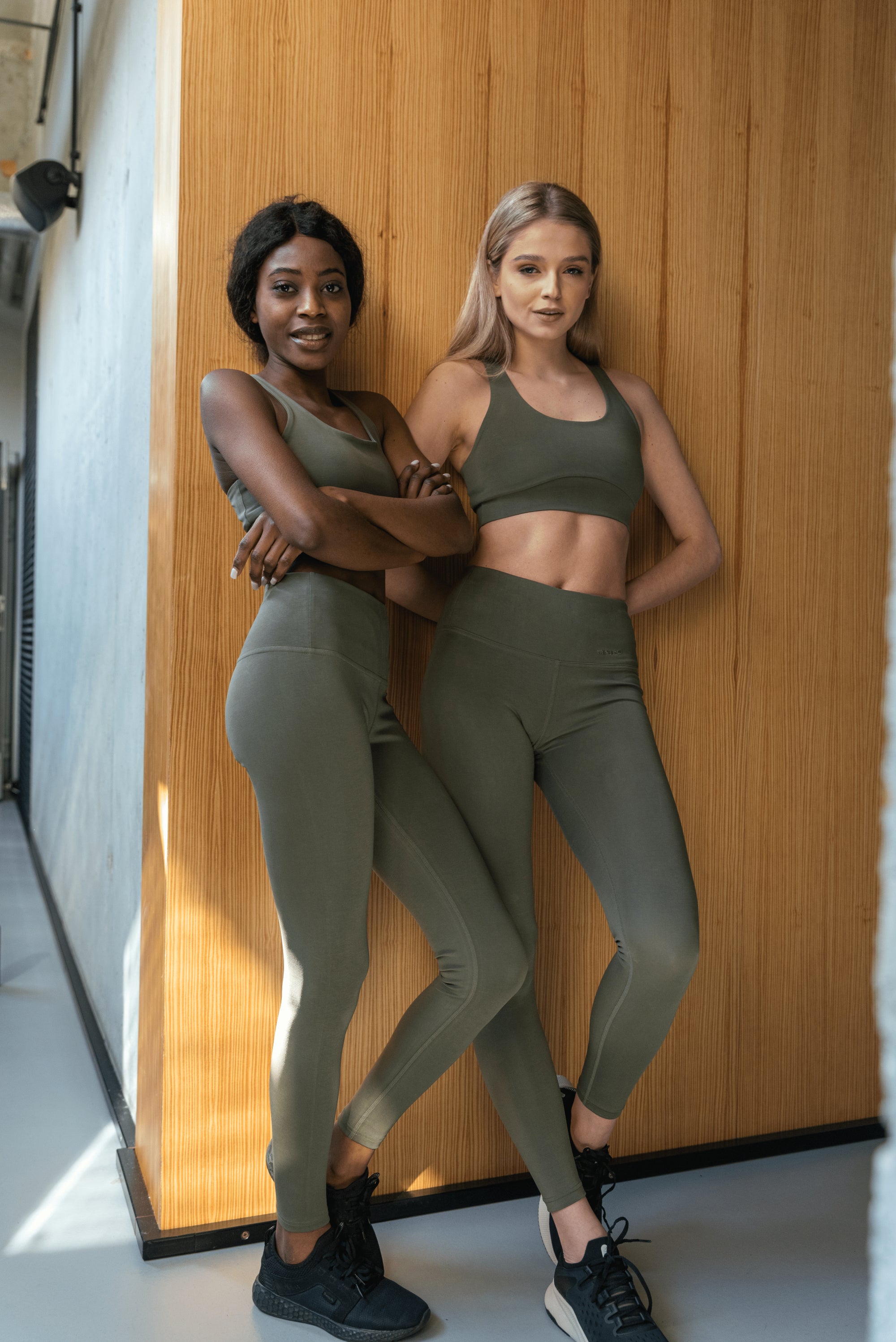
Caption: Tripulse Pro Leggings and Sports Bra Made with TENCEL™.
What is Polyester?
Polyester is the most commonly used textile globally. Almost 70% of our clothing is made from polyester and other synthetic fibers. Take a look at the material labels in your wardrobe and we’d wager most adorn this prolific fabric. Feeling dubious? Join our challenge and let us know your results!
So what exactly is polyester?
Polyester is a man-made synthetic fiber derived from petroleum – a natural non-renewable resource. PET (polyethylene terephthalate) is the most popular polymer in fashion. It's made by mixing chemicals terephthalic acid (PTA) and ethylene glycol (EG).
Note: Recycled polyester (rPET) and bio-based polyester are considered more sustainable polyester alternatives. More on this later!
Polyester’s Rise to Popularity: A Brief History
Can you imagine a wardrobe without polyester? It’s hard, isn’t it? But there was a time when synthetic fabric didn’t exist. Our grandparents and great-grandparents would have only worn natural and animal-based materials.
Polyester first made an appearance in the 1940s when chemical fabric processes became more advanced. But it wasn't until the 1990s that the polyester frenzy came into full force along with a new rapacious phenomenon: fast fashion.
Polyester is the magic ingredient that keeps prices low and profit margins high. It possesses all the qualities that make it so irresistible to brands and consumers. Cheap, durable, moisture-wicking, stretchy – to name a few.
Yet polyester has come under fire in recent years. Its popularity is waning amid growing health and environmental concerns. Keep reading to find out more!
TENCEL vs Polyester: A Deep Dive into the Pros and Cons
Now it’s time to get down to the nitty-gritty of the TENCEL vs polyester clothing debate!
When choosing new activewear or clothing you must make the right decision for you. It's also important to consider how your clothing choices can affect your health, people and nature.
That’s why we’ve created a handy pros and cons list based on these factors:
- Performance
- Versatility and durability
- Comfort
- Sustainability and health
- Cost
What are the Advantages of TENCEL?
Breathable and Moisture-Wicking
TENCEL is quick-drying and very efficient at absorbing moisture. The cellulosic fibers are naturally structured to regulate the absorption and release of moisture. The result? Activewear that feels cool, dry and super comfortable – like a second skin!
Skin-Friendly and Naturally Hypoallergenic
Are you prone to sensitive skin and allergies? If so, TENCEL might be the perfect material for you!
Here's why TENCEL is gentle on the skin:
- It's friction-free and has an incredibly smooth surface.
- It's thermoregulating which means it supports the body to regulate your temperature.
- It's antibacterial and free from toxins which reduces the risk of skin irritation.
Did you know? A study by Frontiers of Medicine found 60-70% of women report having sensitive skin. Almost every woman we speak to experiences skin irritations while working out in synthetic activewear. Many women take it as a burden that should be accepted. But it doesn’t have to be this way!
Discover how Tripulse activewear made with TENCEL can change your workouts (and life!) for the better.
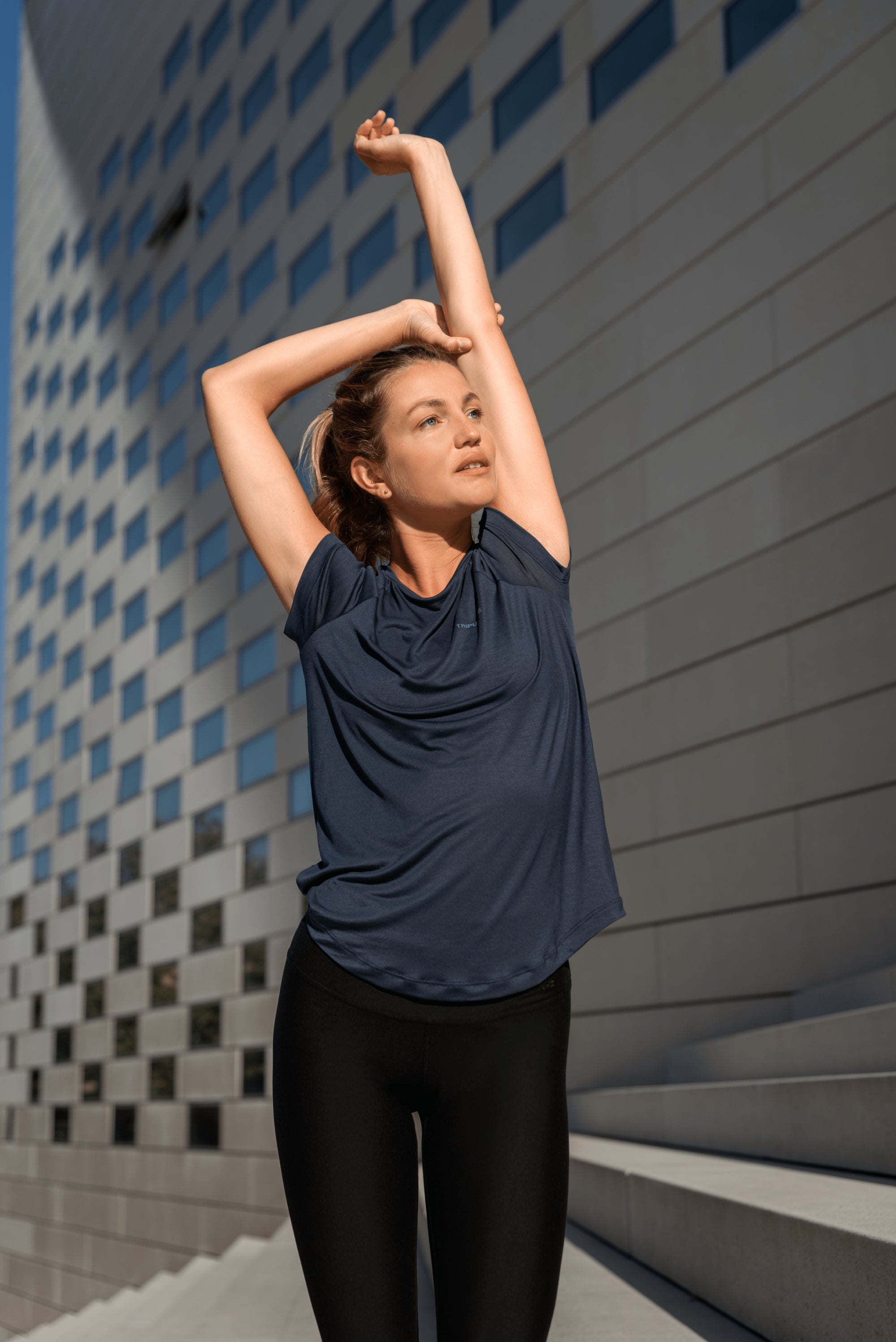
Caption: Tripulse highly breathable and skin-friendly activewear made with TENCEL.
Odour Resistant and Antibacterial
That’s right – say goodbye to pesky bacteria and bad smells!
TENCEL’s moisture-wicking properties create an unfavourable environment for odour-causing bacteria to grow. Enjoy long-lasting freshness without worrying about unpleasant odours or endless washing cycles. Plus, reduced washing frequency equals huge energy savings and less need to invest in new clothing.
Our customers wear their Tripulse activewear countless times before washing them. Here’s an example from Kimberly sharing her experiences wearing our Original Leggings 2.0 Made with TENCEL:
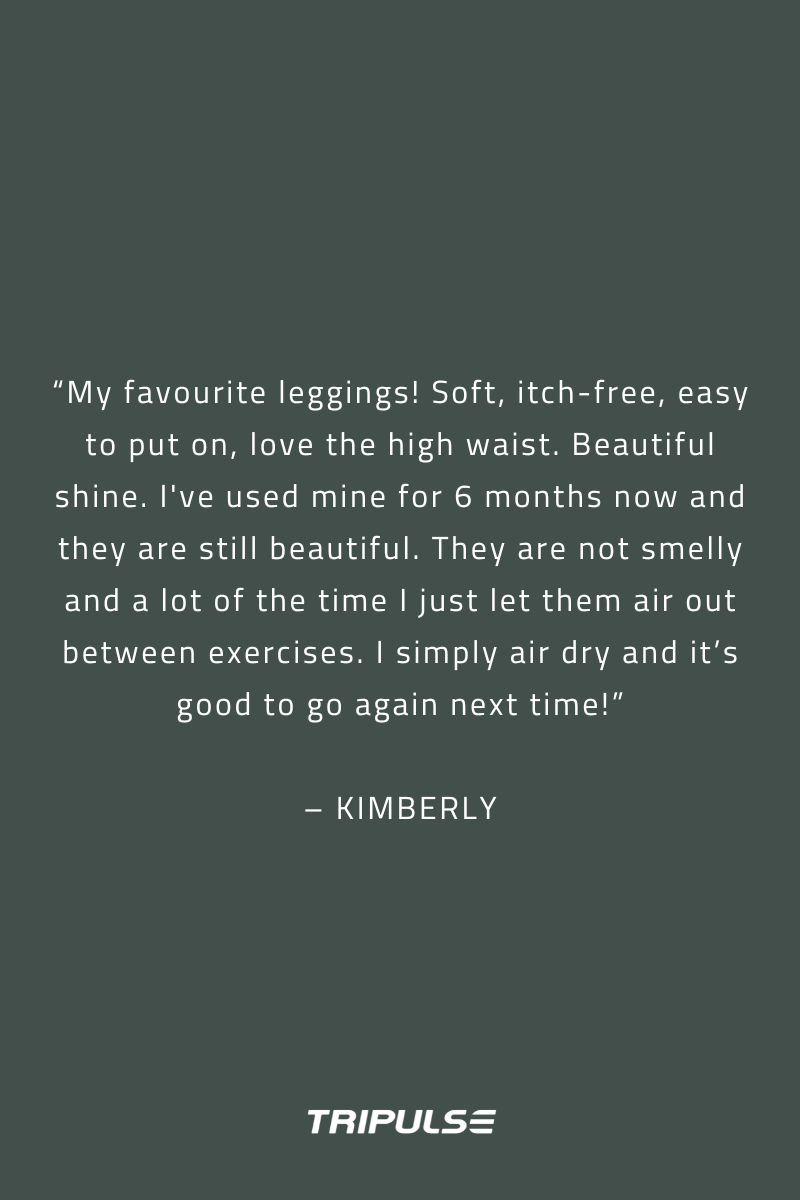
Caption: So many of our customers find they stay fresh and comfortable for longer when working our in Tripulse activewear made with TENCEL!
Pro tip: If exercise is part of your daily routine, investing in activewear made with TENCEL is your best bet! It's moisture-wicking, thermoregulating and odour-resistant making it the perfect workout companion. Hence why we use TENCEL to create all of our sustainable activewear.
Low Environment Impact (Certified Biodegradable and Compostable!)
As mentioned above, TENCEL is an extremely earth-friendly fabric. It’s naturally derived from sustainably sourced wood pulp and follows an eco-conscious closed loop production process. Plus, when it reaches the end of its natural life, the fibers can fully revert back to nature. Under the right conditions, it only takes 3 months for TENCEL to rejoin nature’s cycle!
Note: TENCEL can naturally break down if it’s free from non-biodegradable materials. Before popping your TENCEL garment in the compost, it’s worth checking the clothing label. Synthetic fabrics such as elastane could be lurking!
The TENCEL fabric used in Tripulse activewear is certified biodegradable and compostable. Our t-shirts and tank tops are made with 100% TENCEL. We also blend our leggings and shorts with biodegradable elastane for maximum movement.
Free From Toxins
Most clothing these days is processed with a deluge of toxic chemicals. Unless a garment displays sustainability certifications, then toxic residue could still be present.
TENCEL fabric is the healthy exception to the fashion rule. It completely omits the use of harmful chemicals during production. How? Because the fabric is only processed with one organic solvent that is safe and non-toxic.
Pro tip: It's always worth checking a brand’s sustainability credentials before making a purchase. For example, our dyed TENCEL material is OEKOTEX STANDARD 100 certified and REACH compliant. This means our activewear is certified safe and free from harmful chemicals.
Check out our sustainability page to learn more about our sustainable fashion certifications!
Durable, Functional and Timeless
TENCEL is an exceptionally durable and functional fabric. It's high-performing and designed for comfort and maximum movement. Hence why it’s the perfect material for an active lifestyle! Its ability to wick away moisture means it has a strong composition and drapes well.
Plus, Tripulse activewear made with TENCEL is considered a versatile and timeless wardrobe staple by many of our customers:

Caption: We love to hear our customers can effortlessly style their activewear made with TENCEL for many different occasions!
What are the Disadvantages of TENCEL?
Higher Price Point
TENCEL clothing can be more expensive compared to cheaper synthetic and plant-based materials. The premium price point is partly due to the way the cellulosic fibers are processed.
Producing TENCEL is more costly than other fabrics. This is because it follows an eco-friendly closed loop manufacturing process. If the TENCEL garment is then made in a certified factory with high environmental and ethical standards, this also pushes the price up!
A Note on Affordability
Compared to low-cost fabrics, TENCEL clothing certainly presents a higher price point. But is cheap really better?
Fast fashion dominates high-street stores and online shopping. Mainstream brands are endlessly churning out on-trend garments at irresistible prices. The fast fashion business model prioritises speed and the bottom line. Product longevity and ethics are invariably passed up in pursuit of profit. The result? Low-quality clothing with a huge cost to people and the planet.
So, is it possible to reframe how we shop for our activewear and clothing?
Fast fashion is attractive and affordable at the time but trends fade and quality wanes.
Could investing in a few high-quality and versatile items be the better option?
Think about it. The lifespan of cheap and unsustainable items is often short-lived. This means you need to replace your clothing more often. What about if you opted for a handful of durable and timeless pieces instead, but less often? Could this actually save you money in the long run?
Not quite convinced? Here's a quick case study!
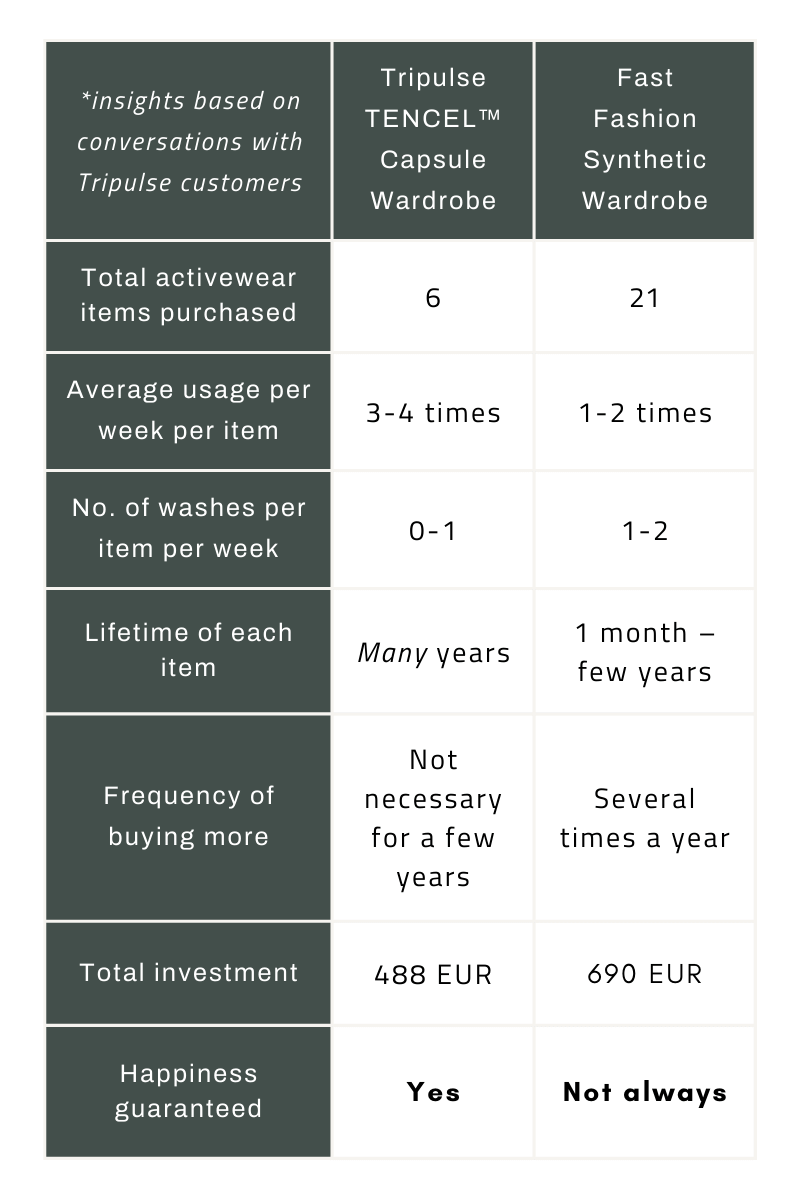
Caption: A quick overview of Tripulse customer experiences wearing TENCEL vs polyester and other synthetic activewear.
Our customers shared their experiences wearing synthetic activewear compared to Tripulse sustainable activewear.
Before wearing TENCEL activewear, customers found they needed to replace their synthetic activewear more often. This was mainly due to poor quality, fit and lack of versatility. Now, customers own a smaller capsule activewear wardrobe consisting of only a few Tripulse pieces fit for all their workouts and leisure purposes.
Read this blog to discover how investing in a small number of high-quality and timeless activewear essentials made with TENCEL can equal huge savings!
Requires Extra Care
TENCEL is a very versatile and durable fabric. However, if you decide to invest in TENCEL activewear or clothing, it’s important to adopt a caring mindset. This will ensure your garments stay in circulation for as long as possible.
Caring for TENCEL fabric can take up more time compared to other fabrics such as polyester. Here are some sustainable care tips to keep in mind if you decide to invest in TENCEL:
- Never wash TENCEL clothing at a high temperature.
- Ideally hand wash or wash on a cold water setting. Always wash inside out.
- Never tumble-dry as this will destroy the fabric.
- Don’t bleach to avoid colour loss.
- Avoid fabric softeners and use mild earth- and health-friendly detergent.
Pro tip: Why not consider washing less and air-drying more? Depending on the fabric, you don’t need to wash your clothes after every use. Tightly woven fabrics such as polyester retains heat and odour-causing bacteria. This can force us into endless washing cycles and higher energy bills.
TENCEL is naturally breathable and odour-resistant so you won’t need to wash your clothing as much. Simply air-dry your garment and it will be good to go again the following day!
What are the Advantages of Polyester?
Durable and Stretchy
Polyester is derived from plastic which means it can be strong and long-lasting. However, this is only the case if planned obsolescence isn’t lurking in the design – more on this later!
Polyester is resistant to abrasion and can withstand a lot of activity without tearing or pilling. Hence why it’s ubiquitous across the activewear industry. Polyester is also stretchy if blended with other materials such as elastane or Lycra.
Affordable
It’s hard to ignore polyester’s irresistible price tag. Polyester is much (much!) cheaper to produce compared to natural materials. For example, it costs half as much per kilo to produce compared to cotton. This allows (fast fashion) brands to quickly generate high volumes of clothing at a low cost.
Not everyone can afford the initial investment when it comes to plant-based fabrics. For that reason, polyester’s affordability has made clothing accessible to more people.
Easy to Care For (Wrinkle- and Stain-Resistant)
A life of convenience. That’s what most of us yearn for as we navigate this busy modern world! And when it comes to our clothing, we want a low-maintenance fabric that will simplify our schedule. Right?!
When polyester first came on the scene, it was marketed as a “wash-and-wear” fabric. It doesn't need to be ironed after laundering and is resistant to stains.
Polyester’s molecular structure absorbs minimal water. As a result, it tends to hold its shape and is less susceptible to wrinkling.
Note: A deluge of toxic chemicals are often added to polyester to make it wrinkle- and stain-resistant. Keep reading to find out more!
What are the Disadvantages of Polyester?
Haven for Odours and Bacterial Growth
News flash: you don’t smell. Your polyester workout clothes do!
Contrary to popular belief, bad odours shouldn’t have to be a “natural” (and let’s face uncomfortable) part of your workout experience. The lingering smells are largely down to the synthetic threads clinging to your skin. And it could be holding you back.
Did you know odour-causing bacteria love polyester and other synthetic fabrics? The tightly woven material can easily trap heat and moisture. When you start to move and sweat, this creates the perfect haven for bacteria and unpleasant odours to flourish. This can profoundly impact your performance, comfort and confidence.
And don’t just take our word for it! Research by Ghent University studied microbial growth and odour development in cotton and synthetic fabrics – including polyester. Workout t-shirts were collected from 26 healthy individuals after an intense spinning class. They found the polyester t-shirts smelt “significantly less pleasant” compared to cotton t-shirts. Not to mention the odour-causing bacteria Micrococcus was prolific in all of the synthetic t-shirts but non-existent in the cotton fabric!
So you see, the unpleasant smells that occur during and because of the fabric, not you. What you’re experiencing is normal and something you shouldn’t feel embarrassed or ashamed of. You’re simply working out in the wrong material.
Pro tip: Move with plants, not polyester! Say goodbye to stinky synthetics and hello to natural alternatives like TENCEL. TENCEL is an exceptional fabric because it’s anti-bacterial and odour-resistant. The cellulosic fibers are incredibly moisture-wicking and efficient at slowing bacterial growth. Exercising in TENCEL activewear has been a complete game-changer for many of our customers. They stay fresh for longer and have regained so much confidence!
Are you ready to ditch the plastic and move with nature? Discover Tripulse activewear made with TENCEL.

Not Breathable or Skin-Friendly
Have you ever experienced skin irritation or rashes during a workout? If so, you’re not alone!
Sweating in synthetics can aggravate sensitive skin. Unlike natural fibers, polyester doesn’t allow the skin to breathe. It’s a densely knitted fabric designed to repel moisture and keep you dry. As you sweat, polyester traps kheat and bacteria causing you to feel itchy and smelly.
Research also shows the dyes and chemicals used to make polyester can trigger skin and other health problems. PFAS (forever chemicals) are used to make polyester waterproof and stain-resistant. A recent study discovered new flight attendant uniforms made from polyester contained a concoction of harmful chemicals, including PFAS and BPA. Flight attendants experienced multiple chemical sensitivities such as irritated skin, hives, rashes, blurred vision and more.
PFAS are also carcinogenic and contain endocrine-disrupting chemicals (EDCs). This means they can interfere with your body's hormonal systems. Keep reading to find out more about polyester’s toxicity!
Planned Obsolescence
Polyester fabric is a strong material. That said, it’s often the fabric of choice when executing fast fashion’s dirty ploy: planned obsolescence.
Planned obsolescence is where clothing is intentionally designed to be short-lived. Garments are often made poorly and mimic styles that go out of fashion quickly. And it’s intended to do one thing: make consumers consume more!
This study on fashion consumer behaviour found over 50% of people purchased new garments due to poor quality. Almost 40% of consumers said there was no problem with their current clothing but wanted to keep up with the latest trends.
High Environmental Impact
- Derived from fossil fuels: Polyester has been environmentally damaging since its inception. It's manufactured from crude oil – a finite, non-renewable and highly polluting natural resource. Producing synthetic fabrics uses approximately 342 million barrels of oil every year.
- Energy-intensive: Polyester production generates a colossal carbon footprint. Two square metres of polyester fabric creates around 6.4kg CO2e. That’s the same as an average gasoline-powered car driving for 32.5km. In 2015, polyester production emitted 282 billion kg of CO2 – nearly three times as much as cotton.
- Non-biodegradable: Unlike TENCEL’s circular supply chain, polyester follows a linear production model. This means when we dispose of polyester, it can’t revert back to nature. Instead, polyester takes thousands of years to degrade.
- Microfiber pollution: Polyester breaks up into tiny microfibers when it decomposes. Up to 4,000 tiny fibers per gram of fabric disperse into water systems and the ocean when washed. One person washing their polyester clothes for a year could release 300 million particles. Microfibers are also hurting wildlife. A study found microfibers in the digestive tracts of marine species causing several toxic effects from DNA damage to physiological alterations.
- Harmful chemicals: The dyes and finishing treatments used to make polyester clothing contain enormous amounts of toxic chemicals. Chemical waste leaks into waterways during production. This can be devastating for garment workers, surrounding communities, and the environment. The Citarum River in West Java, Indonesia has 2,000 industrial facilities (mainly textile factories) peppered along its banks. Dangerous toxins are frequently discharged into the water, changing the colour of the river, and slowly poisoning local ecosystems. Faecal coliform bacteria present in the water is more than 5,000 times the mandatory limit. Lead levels are also more than 1,000 times over the US Environmental Agency drinking water standard.
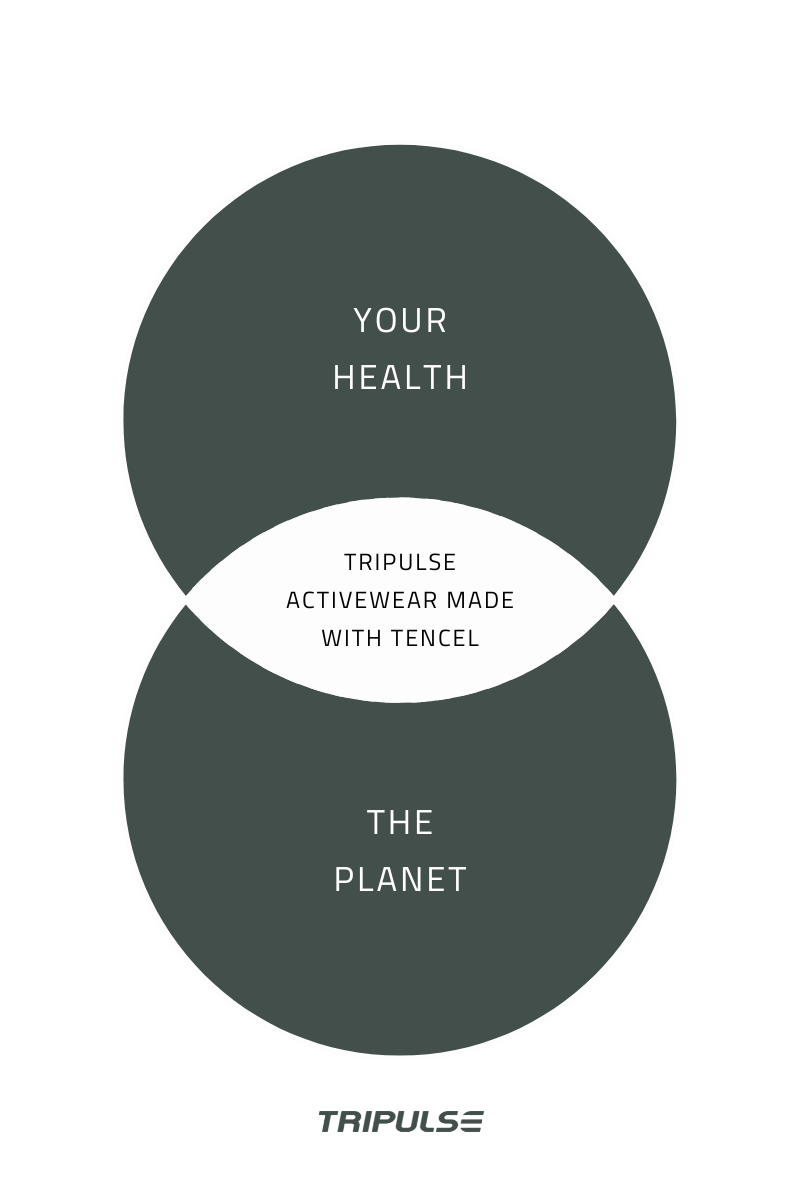
Caption: Tripulse activewear made with TENCEL helps you make better choices for yourself, people and the environment!
Risk of Toxin Exposure
Toxic threads may still be lingering on polyester garments after production. Polyester is a beloved fabric because it possesses all the attributes consumers desire. The downside? Polyester is layered with a myriad of harmful chemicals to achieve these qualities. When we sweat, chemicals have been found to release from the fabric and leach into our bodies.
For example, polyester has been found to react to your body heat causing the chemical antimony to release and absorb through the skin when you sweat. Antimony is used in polyester as a flame retardant and catalyst during the PET manufacturing process. It’s a known carcinogen and can negatively affect the skin, eyes, lungs and throat.
Interested in finding out more? Read our article about toxins in clothing and discover how you can detox your activewear wardrobe today!

Caption: Tripulse sustainable activewear made with TENCEL is certified safe and completely free from harmful toxins.
A Note on Recycled and Bio-Based Polyester
What is Recycled Polyester?
Recycled polyester (rPET) is considered a sustainable alternative to regular polyester.
Post-consumer or post-industrial plastic waste is diverted from landfills and transformed into polyester clothing. Recycled polyester uses less resources and prevents plastic from polluting the environment.
The catch? Recycled polyester is still derived from plastic. It therefore can't biodegrade and releases harmful microfibers into the natural world.
Fashion brands tend to follow a chemical process when recycling polyester. Garment workers and the environment could be put at risk if chemicals are ill-managed. Plus, contaminants have been found in recycled plastic such as phthalates, flame retardants, and heavy metals.
Pro tip: Considering recycled polyester? Look out for third-party sustainability certifications that ensure the garment is toxin-free. We still only recommend wearing rPET clothing that isn’t next to the skin and requires minimal washing. To prevent microfiber pollution, it’s worth investing in a filter for your washing machine.
What is Bio-Based Polyester?
Bio-based polyester is considered another sustainable alternative to standard polyester. Unlike oil-derived polyester, bio-based polyester is partly or fully derived from plant-based materials. Sugarcane, corn, biomass feedstocks – the list goes on!
But here’s the snag. You can’t always guarantee biopolymers are manufactured sustainably and ethically. Some bio-based fabrics will have a larger impact compared to others. For example, environmentally damaging fertilisers and pesticides could be used to source some raw materials. Plus, not all biosynthetic materials are biodegradable. This means they can't break down in the environment naturally and will likely end up in landfills. Plus, the land used for the raw materials can compete with food production. This doesn’t bode well in a world where one-in-ten people still don’t have enough food to eat.
For this reason, always check the sustainability credentials of a brand or garment before purchasing!
Building a Plastic-Free Wardrobe with TENCEL: 4 Simple Steps
So, you’ve made your decision. When it comes to the TENCEL vs polyester conundrum, TENCEL is the obvious choice. It’s better for your health, the environment and the people who make the clothes. It also feels so much better too – like a second skin!
Let’s be real. Most of our wardrobes contain polyester. It’s not as simple as immediately switching your entire wardrobe to TENCEL. This isn’t realistic or sustainable.
It’s important to recognise building a sustainable lifestyle is a life-long process. After all, Rome wasn’t built in a day!
But don’t worry. We have some simple suggestions you can gradually implement over time. Sustainable living is a beautiful journey, and we’re here to support you every step of the way.
Assess Your Current Wardrobe
First off, create an inventory of what you already own.
When sorting through your clothes, consider the following:
- Review clothing labels: Do you own any garments made from natural materials? What portion of your wardrobe is plastic-based materials? Knowing this will help you be more strategic when improving your wardrobe over time.
- Assess the current condition of your garments: Can any item be repaired? Perhaps they can be upcycled into something new? Also, consider thrifting or swapping with friends rather than throwing them away.
- Identify gaps: What clothes are you missing from your wardrobe? Fill any gaps with high-quality and versatile TENCEL staples. Choose timeless styles over finite fashion fads. Take a look at Tripulse's sustainable activewear for inspiration!
Pro tip: Not quite ready to break up with polyester right away? Consider keeping hard-wearing polyester items such as coats or bags. That way you don't need to wear them close to your skin or wash them very often.
Replace Polyester Items Gradually
Keeping your clothes in circulation for as long as possible is important. Replacing all your polyester clothing right away is wasteful and hard to achieve.
Completely new to TENCEL clothing? We recommend adding one or two TENCEL items to your wardrobe to start with. Consider investing in TENCEL basics that you will wear often and close to the skin. For example, sustainable activewear made with TENCEL.
Over time, gradually replace your old polyester garments with healthy and sustainable TENCEL alternatives.
Pro tip: Why not try upcycling your old polyester garments? Transform old fabric into tote bags, headbands, or hair scrunchies. Avoid polyester items that are worn close to the skin or have to be washed often. This will reduce the risk of toxin exposure and microfiber pollution.
Look Out For Sustainable Fashion Certifications
A sustainability certification is a regulated third-party standard. It demonstrates a brand’s deep commitment to environmental and ethical practices. Sustainability certifications ensure your activewear or clothing is made with great care for your health, people and the environment.
It’s important to always try to seek true transparency. Look for clear information on a brand's website. Don't be afraid to ask questions via email or on social media.
Need some help navigating the world of sustainable fashion certifications? Our handy sustainable fashion certification checklist has you covered!
Consider Your Clothes as Life-Long Investments
Polyester is so cheap that it’s easy to get sucked into the throwaway mindset. Replacing our clothes sometimes feels like the only option when so many garments lack quality, function and style.
But what if we could view our clothes as life-long investments instead?
TENCEL may feel like a bigger investment compared to polyester garments. But the latter is often made poorly, follows finite fashion fads and isn’t fit for every purpose. This is especially the case for activewear! You then end up buying many low-quality items to try to meet your wardrobe’s shortcomings.
Instead, why not try adopting a minimalist mindset? Invest in a few high-quality and timeless TENCEL items you will wear for many years. Choose fashion brands that operate a slow fashion model where durability, performance and sustainability are considered every step of the way. That way you won't feel, or need, to replace your wardrobe as often.
And let's not forget. Our clothing choices are so much more than a mere fashion statement! Building a natural, healthy and long-lasting wardrobe can be a powerful investment in your wellbeing and the planet. We often don't consider how much our clothing choices can impact our health and the world around us. Just like the food we consume, the fabric we wear can be life-changing.
Are you ready to feel the difference? Build a healthy and life-long wardrobe with Tripulse activewear made with TENCEL.
Caption: Ditch the plastic and move with Tripulse sustainable activewear!
TENCEL vs Polyester FAQ
Is TENCEL Good For Hot Weather?
Yes! TENCEL fibre is perfect for hot weather – especially when you exercise. It's known for its breathability, moisture-wicking and odour-resistant properties. Plus, TENCEL feels so smooth and soft against the skin. It can help keep you cool and comfortable by wicking away moisture and allowing airflow.
For example, our TENCEL Made to Move Shorts are the perfect staple during the warmer months. Here’s a great story from one of our customers:
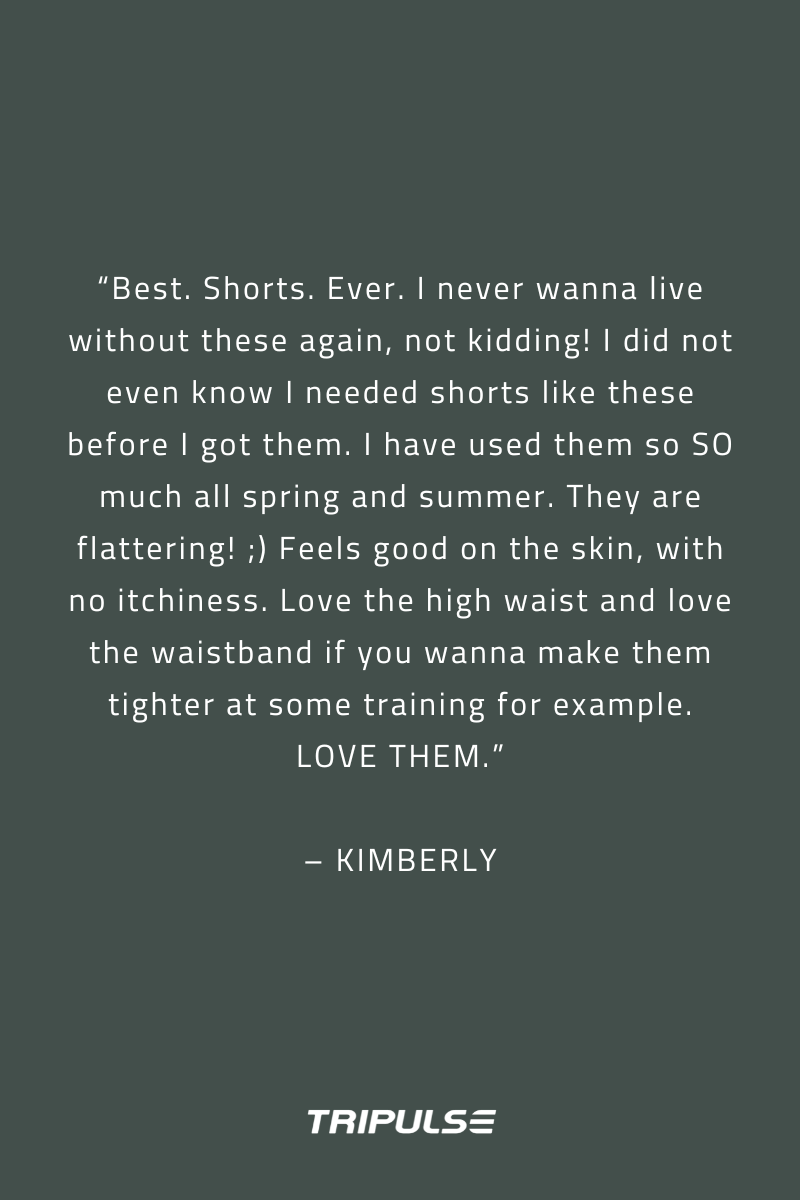
Caption: It's so wonderful to hear our customers are keeping cool and comfortable while wearing Tripulse activewear made with TENCEL!
Shop Tripulse's sustainable activewear and feel the difference.
Is TENCEL Good for Your Skin?
Yes! TENCEL is a naturally skin-friendly and hypoallergenic fabric. It can help promote comfort and well-being – especially if you have sensitive skin.
So much of our activewear and clothing is made from synthetic fabrics like polyester. Synthetic fibers are not breathable and trap heat and bacteria. This can cause skin irritations and unpleasant odours!
Is TENCEL Good Quality?
Yes! TENCEL is known for its durability, softness, and luxurious feel. Hence why it's becoming a popular clothing option – especially for activewear. TENCEL fibers are sustainably sourced and known for their strength and resilience. This means they are less prone to pilling or tearing compared to other fabrics.
Curious to see TENCEL clothing in action? Check out our high-performing and versatile activewear collection.

Caption: Tripulse high-quality and versatile Original Leggings 2.0 made with TENCEL.
Is TENCEL Stretchy?
TENCEL fabric itself is not inherently stretchy. However, it can be blended with stretchy fibers to add flexibility to the fabric.
Some TENCEL garments are interlaced with plastic-based materials. For example, elastane or Lycra are non-biodegradable and contain hazardous toxins.
That said, it is possible to make TENCEL stretchy without adding harmful materials! Our workout leggings and shorts contain a special blend of TENCEL and ROICA V550. ROICA V550 is a compostable version of elastane. It's Cradle-to-Cradle certified with the material health category “gold”. The result? Sustainable activewear with superior stretch, performance and mobility.
Viktiga länkar från Tripulse Träningskläder:
Legging Tencel | Tencel T shirt | Leggings Med fickor | Tencel Tyg | Snygga löparkläder Dam
Would you like to get the latest blog posts such as this one, exclusive news and offers and more info about sustainability and activewear right into your inbox from time to time? Then sign up to our newsletter HERE.













